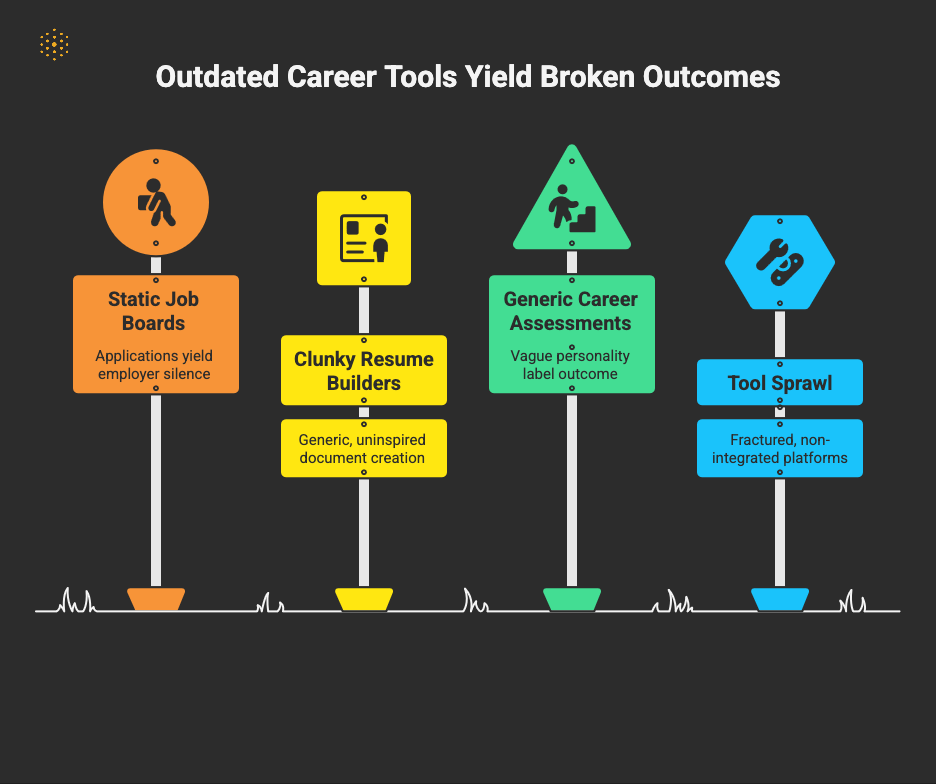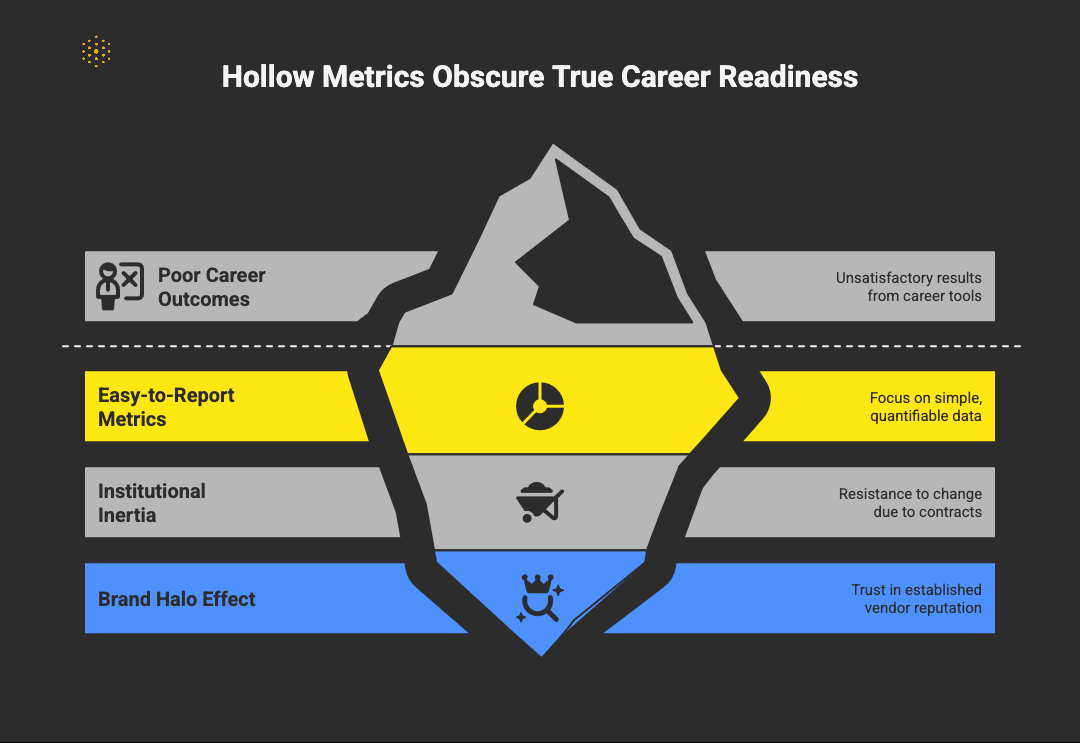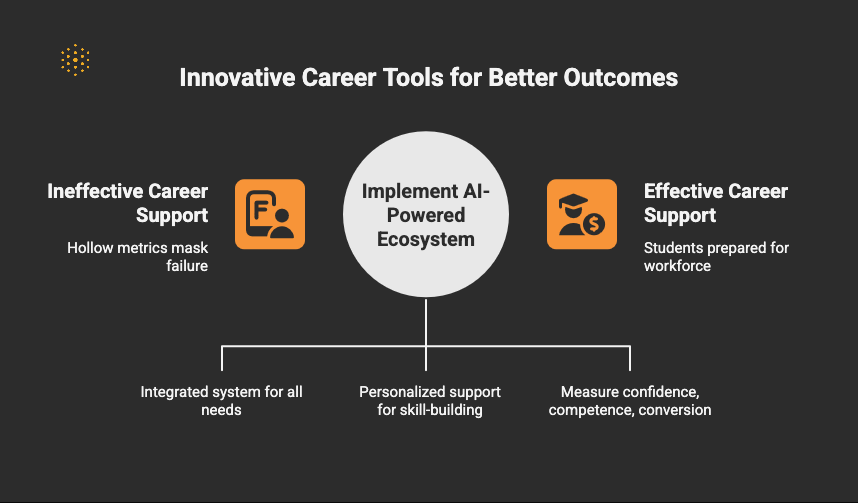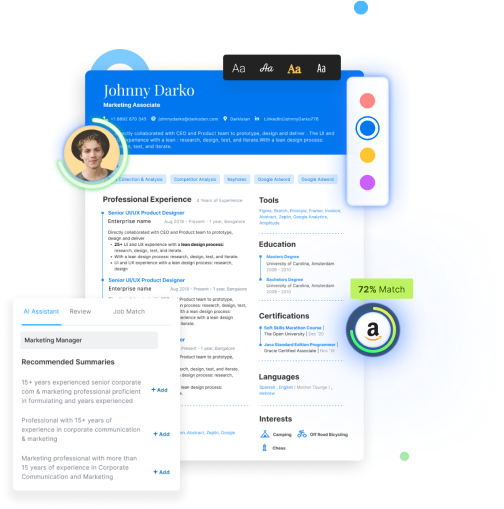What should career centers do to move beyond activity metrics and drive real career outcomes?
Replace fragmented, activity-focused tools with a unified AI system that builds skills, boosts confidence, and tracks outcomes. Shift KPIs from logins and applications to quality assets, skill gains, advisor coaching time, and job conversions.
Career centers are investing heavily in technology, but most tools still measure activity, not readiness.
Dashboards glow with record-high “engagement”- thousands of logins, clicks, and applications. On paper, it looks like success.
In reality, it hides a growing problem: students are applying dozens of times with little to show but rejection emails and declining confidence.
A year later, many join the 41% of recent graduates who report feeling underemployed.
Until career services redefine what “effective” support means, we’ll keep celebrating hollow metrics while students leave campus unprepared for the workforce.
University career centers must shift their focus from legacy platforms that measure superficial activity to modern, AI-powered ecosystems that demonstrably build skills, confidence, and tangible career outcomes.
Let’s look closer at where these tools fall short, and why career centers need to rethink their approach.
Outdated Career Tools = Broken Outcomes
The digital toolkit offered to students today is often misaligned with the results they actually need.
Career platforms still measure “success” through usage like logins, resumes uploaded, applications submitted, while ignoring whether those actions translate into real jobs.
- Static Job Boards: We celebrate when students submit hundreds of applications, but the real outcome is often silence from employers. For many Gen Z graduates, the experience has been described as hellish - submitting over 150 applications, with roughly 80% receiving no response at all. The result is application fatigue and the false conclusion that “there are no jobs for me.”
- Clunky Resume Builders: A platform might record a “resume created,” but the product is often a generic, uninspired document. Instead of teaching students how to position their unique value, these tools encourage box-checking and template-filling.
- Generic Career Assessments: Students complete a quiz, the dashboard records another tick, but the outcome is a vague personality label, not a roadmap that connects their strengths to in-demand skills and viable career paths.
- The Bigger Problem: Tool Sprawl: This problem is compounded by the fractured ecosystem of non-integrated platforms. One system for resumes, another for interview prep, and yet another for career assessments. The result isn’t just inconvenience, it’s fragmentation. Students and advisors alike struggle to piece together a cohesive, strategic career plan. Data is siloed, and the dots between a resume draft, a mock interview, and an eventual job offer are never connected.

The Consequences: Underemployment as the Norm
The cost of this misalignment is severe.
Roughly 1 in 2 graduates land in jobs below their training level, and many stay there for years.
Before overhauling its system, Shawnee State University saw this disconnect firsthand. Student engagement with career services was less than 10% because the existing tools were so “clunky” that students abandoned them.
The result was the “apply and pray” method: students submitted large volumes of applications, only to be met with silence. The outcome was more than rejection, it was demoralization.
Students felt not only dismissed by employers but also unprepared by their university. Confidence eroded at the very moment they needed it most.
Advisors were caught in the same trap. When technology fails to provide meaningful, scalable support, the burden shifts to them.
Also Read: How to improve FDS response rates?
Why We Cling to Them: The Comfort of Hollow Metrics
If the outcomes are so poor, why do these tools persist? Because we are trapped in a cycle of measuring what's easy, not what's effective.
- The Allure of Big Numbers: Thousands of logins, résumés uploaded, or applications submitted are simple to report. Long-term measures - like job satisfaction, salary growth, or career mobility, are harder to track. As NACE notes, career centers have traditionally leaned on metrics like workshops offered or interviews scheduled, rather than whether these interventions actually improve outcomes.
- Institutional Inertia & Vendor Lock-In: Restrictive contracts and the perceived hassle of switching platforms create resistance to change. Familiar dashboards feel “safe,” even when they’re failing students.
- The Brand Halo Effect: Tools from large, established vendors are assumed to be “good” simply because of their reputation. In reality, many of these platforms are built on outdated frameworks designed for counting activity, not building readiness. Career centers stay loyal to brand names instead of exploring newer, more effective solutions, leaving innovation on the sidelines.
Also Read: How is Hiration a better Big Interview alternative?

From Transactional to Transformational: Redefining "Effective" Support
A new model of career services is emerging, one where technology takes care of transactional tasks so advisors can focus on transformational guidance.
Instead of tracking logins and clicks, the emphasis shifts to building confidence, skills, and careers.
Case Studies in Redefining Support
- The Shawnee State Turnaround: By replacing its fragmented system with Hiration’s unified, AI-powered platform, Shawnee State increased engagement from under 10% to over 70%. Students weren’t just “applying”; they were building capabilities - creating over 2,500 résumés and 500+ digital portfolios with instant, expert-level feedback. Advisors, freed from clerical work, could finally deliver high-value coaching, turning the career center into a launchpad.
- The Rasmussen University Model: Rasmussen embedded career readiness directly into coursework. With AI feedback integrated into assignments, every student gained access to scalable, personalized support. Career preparation became a core academic outcome, not an optional service, ensuring equity and consistency across the student body.
- Speed and Confidence at Scale At Tech Elevator, where 90% of graduates land a job within 180 days, students use Hiration to build targeted resumes in under 30 minutes, gaining both speed and a competitive edge. At MUST Ministries, clients create confidence-boosting resumes in a single session, a tangible step toward reentering the workforce.
Also Read: Hiration vs VMock - which is the better option for your career center?

Final Thoughts
For too long, we have allowed hollow metrics to mask a systemic failure to prepare our students for the modern workforce. The reliance on outdated, fragmented technology is a disservice to our students, our advisors, and our institutions.
A new paradigm is needed, one that measures what actually matters. Effective career support isn’t about tools; it’s about outcomes. That requires redefining the KPIs career centers track:
- From logins to to skill-building sessions
- From resumes created to quality career assets
- From advisor appointments to advisor hours redirected toward strategic coaching.
The future of career services lies in the courage to measure what truly matters: confidence, competence, conversion rates, and meaningful first-destination outcomes.
As pioneers like Shawnee State and Rasmussen University have shown, a better way is here.
Unified, AI-powered platforms like Hiration are already helping career centers replace vanity metrics with meaningful progress, empowering students to build confidence, advisors to focus on strategy, and institutions to prove real career impact at scale.
The question for leaders is simple: Is your tech stack tracking activity, or is it driving outcomes? Are you managing a platform, or are you launching careers?
Career services leaders face a choice: continue tracking activity, or start launching careers. If you’re ready for the shift, schedule a live demo and experience what a new model of career support looks like.
Frequently Asked Questions
-
What is the main problem with outdated career services tools?
They measure activity, not readiness, emphasizing logins, resumes uploaded, and applications submitted rather than real jobs or skill growth. You see engagement while outcomes stagnate.
-
How do static job boards impact student application outcomes?
You may submit over 150 applications, with roughly 80% receiving no response at all. The result is application fatigue and a false conclusion that there are no jobs for you.
-
What are the consequences of relying on fragmented, non-integrated career platforms?
You face fragmentation, siloed data, and an incoherent path from resume drafts to job offers. Students and advisors struggle to connect resumes, mock interviews, and assessments into a cohesive, strategic plan.
-
Why do career centers continue using these tools despite poor outcomes?
You keep them because big numbers are easy to report, institutional inertia and vendor lock-in resist change, and brand reputations feel safe even when tools are built for counting activity, not building readiness.
-
What is the scale of underemployment among graduates?
Roughly 1 in 2 graduates land in jobs below their training level.
-
What metrics should career centers track instead of logins and applications?
Shift from tracking logins, resumes created, and appointments to measuring skill-building sessions, quality career assets, and advisor hours redirected toward strategic coaching.
-
What results did Shawnee State University achieve after adopting a unified AI-powered platform?
Engagement increased from under 10% to over 70%. Students created over 2,500 résumés and 500+ digital portfolios with instant, expert-level feedback.
-
How did Rasmussen University embed career readiness into academics?
It embedded career readiness directly into coursework, with AI feedback integrated into assignments. Career preparation became a core academic outcome.
-
What outcomes and speed does Tech Elevator report when using Hiration?
90% of graduates land a job within 180 days, and students build targeted resumes in under 30 minutes.
-
What is the "apply and pray" method and why is it ineffective?
It refers to submitting large volumes of applications only to be met with silence. The outcome is more than rejection; it is demoralization.



